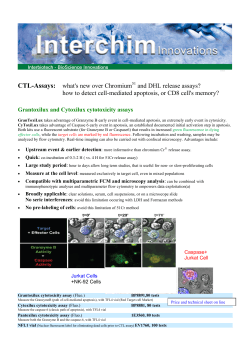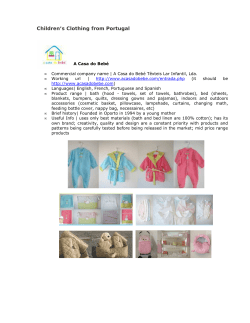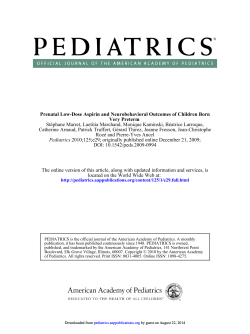
Document 194439
HOW TO IMPROVE DRENCHRlTE®
RJ Dobson 1, PA Stein 1, JH Craven2
lCSIRO, Division of Animal Production, McMaster Laboratory, Locked Bag 1, Blacktown
Australia,
2Horizon Technology, PO Box 598, Roseville NSW 2064, Australia.
2148,
Abstract
Understanding the strengths and weaknesses of DrenchRite and how it relates to faecal egg count
reduction tests (FECRT) will lead to clearer interpretation of DrenchRite results and a better perspective
on both tests. In previous studies efficacy was estimated for worms resistant to BZ, LEV and BZILEV
combinations by FECRT, DrenchRite and post mortem worm counts. Correlations of in vivo efficacy with
FECRT determined by them were: Trichostrongylus colubriformis 88%, Ostertagia circumcincta 56% and
Haemonchus contortus 69%. The low correlation for 0. circumcincta was associated with the variability
in estimating species composition when O. circumcincta was present at low levels. Correlations of
DrenchRite with in vivo efficacy were: O. circumcincta 87%, T. colubriformis 82% and H. contortus 80%.
The correlation between resistance determined by Larval Development Assay (LDA) and FECRT was not
high at 61% (averaged over drugs and species). Similar data for Macrocyclic Lactones (ML) resistant
worms are not yet available.
Previous studies have shown for some LDA systems that eggs are more likely to be inhibited in
development to L3s early (2-3 weeks post infection (PI)) and late (beyond 10 weeks PI) after infection and
are most resilient to the effect of drugs at about 7 weeks PI. No systematic changes in DrenchRite results
were observed over age of worm infection when tested weekly for 2 to 14 week old worms.
Large bowel worms of sheep have not generally been examined under LDA conditions so a study was
undertaken to determine the LD50s of susceptible Oesophagostomum columbianum (nodule worm) and
Chabertia ovina (large mouthed bowel worm) on DrenchRite plates. LD50s for BZ and LEV were
approximately 0.04 and 0.8 uM respectively for both worms. For the ML O. columbiclnum had a much
higher LD50 (45 nM) than C. ovina (8 nM). In relation to the other common sheep worms, development
characteristics of C. ovina in LDA is like H. contortus while O. columbianum is more like O.
circumcincta. Both large bowel worms were very sensitive to BZILEV combinations, with LD50s 4 to 8
fold lower than those observed for H. contortus and O. circumcincta.
Introduction
discussion paper we examme the
relationship between post mortem worm counts,
FECRT and DrenchRite results (1). The stability
of DrenchRite results in relation to worm age will
be reviewed together with some recent results
from LDA studies. And the sensitivity of some
large bowel parasites which are commonly found
in worm egg counts is also described.
was estimated by FECRT, LDA and post mortem
worm counts (1).
In this
Correlation of in vivo efficacy with FECR
(averaged over drugs, and expressed as the
percentage of the total variance that was
explained by the regression analysis) was best for
T. colubriformis (88%) and worst for O.
circumcincta
(56%) with H.
contortus
intermediate at 69%. The low correlation for 0.
circumcincta was associated with the variability
in estimating species composition when 0.
circumcincta was present at low levels. For
example, if the true mean contribution of one
species is 9% then anything between 3% and
15% can be expected from a random sample, and
the range for a mean of 4% is 0%-8%. Thiskind
FECRT, LDA vs. Post Mortem Worm Counts
Sheep infected with mixtures of drug resistant and
susceptible strains of Haemonchus contortus,
Trichostrongylus colubriformis and Ostertagia
circumcincta were treated with a benzimidazole
(BZ), levamisole (LEV) or a BZILEV
combination to determine drug efficacy. Efficacy
16
of variability in % species composition can yield
widely differing results for FECR when the total
egg count is high (ie. when H. contortus and/or T.
colubriformis are present in large numbers). The
current caution applied to FECRT is that the mean
FEC needs to be greater than 200 eggs/gram
before trusting a FECRT result. An additional
restriction: that a species represent more than
15% of the egg count should be applied before a
valid FECRT can be assumed for that species.
the and the ML concentration doubles each well
to the maximum concentration in well 12.
This data shows between well 5 and 6 about 87%
of the susceptible T. colubriformis are prevented
from developing to L3s, while the remaining 13%
of the susceptible T. colubriformis are not
affected till well 10 (ie. at a 16 fold higher
concentration). In a resistant T. colubriformis
strain (4) no eggs are prevented from developing
till well 11 (where about 40% are affected). This
division of susceptible T. colubrifonnis into 2
populations is not optimum for field detection of
resistance particularly when other worm species
are present. Changing the ML drug used in the
assay may overcome this problem but this will
require continning research.
Correlations of resistance ratio, measured by
LDA, with in vivo efficacy were more consistent.
0. circumcincta was best (87%), T. colubriformis
and H. contortus were similar (82% and 80%
respectively).
The correlation between resistance determine<! by
LDA and FECRT was not high at 61% (averaged
over drugs and species). This indicates that the
two tests are measuring slightly different aspects
of anthelmintic resistance.
Table 1 Percentage of eggs/well inhibited from
development to Infective T. colubriformis
Larvae (% Kill)
The DrenchRite assay, used to estimate drench
efficacy, is based on the correlation of LDA
resistance ratio and in vivo efficacy from the
above study (1). The logical approach is to check
the validity of a new test against the established
one, in this case the FECRT. It is valid to use the
FECRT as a guide to the accuracy of the
DrenchRite estimate of drug efficacy only for T.
colubriformis where there is a reasonable
correlation (77%). For O. circumcincta and H.
contortus, the LDA gives a better estimate of in
vivo efficacy than the FECRT and for these
species the two tests (LDAIFECRT) correlate
poorly (53%).
2
Well # 7
%Kill 90
8
84
o
3
4
5
9
87
10
100
11 12
100100
o
o
o
6
86
Effect of Worm Age on LDSO determined by
LDA
Systematic changes in the concentration of drug
required to inhibit development of 50% of
larvae/eggs present ("LD50") were observed (2)
for BZ, LEV and MLs over time after a single
infection (ie. with worm age). In their study
Amarante et al (2) used a liquid medium for the
LDA, as described by Hubert and Kerboeuf(5).
They demonstrated that eggs are more likely to be
inhibited in development to L3s very early and
late post infection (PI) (ie. 2-3 weeks PI and
beyond 10 weeks PI) and are most resistant to the
effect of drugs at about 7 weeks PI.
A similar study (to 1) for the Macrocyclic
Lactones (ML) has not been conducted' because of
the lack of a suitable range of ML resistant
species and the high cost of undertaking such a
study. LDA has been shown to differentiate
between known ML resistant and susceptible
strains of O. circumcincta (2) and H. contortus
(3). Unpublished data of tlte authors using
DrenchRite has demonstrated that ML susceptible
and resistant (4) T. colubriformis can be
distinguished by LDA. With T. colubrifonnis,
known susceptible strains are divided into two
populations by the ML used in the DrenchRite
plate (Table 1). Well 1 below is the control well,
The authors conducted a similar study with a
single batch of DrenchRite plates prepared prior
to the study and used over a period of 16 weeks.
This assay relies on a drug/agar matrix as the
development medium as opposed to a liquid
medium(2 and 5). One sheep was infected with
McMaster suscepti1?le strain of T. colubriformis.
Two sheep were infected with another susceptible
17
t
Well # 1
%Kill 0
strain of T. colubriformis recently isolated from
Armidale NSW. When infections were patent (22
days post infection) DrenchRite assays were
performed on each sheep and then weekly for 12
weeks except for the McMaster sheep which
stopped shedding eggs after the 8th assay.
Table 2 DrenchRite Well Number of the LDSO for Susceptible T. colubriformis strains in Rows G and
H which contain different analogues of a ML
Assay # 1
2
3
4
6
7
8
9
10
11
12
5
RowG
McM 6.5
6
4.5
5.5
5.5
5
6
3.5
5.S
Ar#1 5.5
5.5
5.5
6
4.5
5.5
4.5
5.5
4.5
5.5
5.5
Ar#2 4.5
5.5
4.5
5.5
4.5
6.5
5
6
5.5
5.5
5.5
5.5
RowH
McM 6.5
6
6.5
6.5
5.5
4.5
5
6
5.5
5.5
6
5.5
Ar#1 5.5
5
5.5
6.5
5.5
7
6.5
5.5
Ar#2 5.5
5.5
6.5
6.5
6.5
6.5
9.5
8.5
6
5
5.5
7
Note: assay #1 was conducted 22 days post infection and the following assays weekly thereafter.
For BZ virtually no variation LD50S was
observed, for 35 of the 36 assays the LD50
occurred between well 4 and 5 (ie.4.5), and was
3.5 for the McMaster isolate on the 5th assay. For
LEV, one of the sheep infected with the Armidale
strain (Ar #1) consistently had an LD50 at well
4.5, the departures from this were at assays 6, 8,
10 and 12 when the LD50 was 5.5, 5.5, 5.5 and 4
respectively. The other sheep infected with the
Armidale strain (Ar #2) consistently showed an
LD50 for LEV at well 5.5 departures being at
assays 4, 5, 10 and 12 with LD50s at wells 4.5, 5,
5 and 4.5, respectively.
The McMaster
strain(McM) fluctuated between 5.5 and 4.5 for
LEV in no consistent way.
For BZlLEy
combinations the LD50 was found at well 5.5 for
a little over 2/3 of the assays, the remaining 10
assays ranged between well 6 and 4.5 in no
consistent way. Table 2 shows well numbers for
ML LD50s for both worm strains and both
analogues of ML used in the DrenchRite plate,
and again no consistent trend emerges.
A similar study to the above was conducted with
BZ and ML resistant strains of H. contortus but
included additional ML only LDA plates so the
two ML compounds (rows G and H) could be
replicated. The susceptible McMaster H.
contortus (McM Hc) strain had a longer prepatent period (about 4 weeks) than the other
strains tested (2-3 weeks), and at 5 weeks McM
Hc still had a low egg count. The BZ resistant
(DAP Hc) strain was isolated at McMaster
Laboratory from local sheep, this strain is also
partially resistant to ML. The other strain used
(only in ML LDA assays) was ML resistant
(CAVRS Hc) and was isolated at Armidale NSW
(6). Figure 1 shows the mean well number at
each sampling time where the BZ-LD50 occurred.
Where the data is missing no DrenchRite plate
was set up for that strain at that sampling time.
Data points are means of 2 or 4 replicates. It is
clear that little fluctuation occurred in BZ LD50s
for either strain over the course of the infection.
Figure 1: DrenchRite well number in which BZ
LDSO occurs for McM Hc (susceptible. ) and
DAP Hc (resistant +) strains over 14 weeks of
infection.
BZLD50s
.
~
.
c
7
• •
6
5
T
<C
4
+
....I
31
4
Q)
E
c
.....
.........
~.5
I
I
11=
6
7
8
9
• ••
~ ~ ~ ~
10 11 12 13 14 15
Weeks post infection
McM Hc and DAP Hc strains were susceptible to
LEV and BZlLEV combinations (data not shown)
and only random fluctuations in LD50 for these
drugs were observed over time. Figure 2 shows
the well number in which the ML LD50s (row H)
occurred for ~AVRS Hc, DAP Hc and McM Hc
(data points are means of 6, 2, and 4 replicates
respectively).
Large Bowel Worms
Despite rumours to the contrary, large bowel
worms, Oesophagostomum columbianum (nodule
worm) and Chabertia ovina (large mouthed bowel
worm) in particular, are still alive and well in the
eastern states of Australia, frequently constituting
up to 30% of the worm eggs found in sheep
faeces. Because the behaviour of these parasites
under LDA conditions has not been studied, we
examined LD50s over time in DrenchRite plates.
Susceptible strains of both species were assayed
weekly for 5 weeks, each assay was replicated
and additional ML assays were conducted each
sampling time. O. columbianum and C. ovina
have pre-patent periods of 6 and 10 weeks
, respectively. When the assays were commenced
the O. columbianum and C. ovina infections (in
separate sheep) were 9 and 10 weeks old
respectively.
Table 3 DrenchRite well number in which
the WSO for Large Bowel Worms occurred
DRUG BZ LEV BZlLEV ML
SPECIES
4.0
O. columbianum 3.5
2.5
6.5
4.0
C. ovina
3.5
4.0
2.5
Like T. colubriformis the 3 H contortus strains
display no consistent systematic change in LD50
over time, although slight divergence in ML
LD50 lines by week 7 may be evident (see Figure
2). No similar study has been undertaken using
DrenchRite plates for Ostertagia spp.
Development in control wells was normal for 0.
columbianum (ie around 90%+ of eggs dispensed
became L3s), however, for C. ovina this did not
occur till week 12 despite a high egg count (about
500epg) at 10 and 11 weeks PI. The poor
development of C. ovina immediately after
patency could mean that a high proportion of eggs
were not fertile. Apart from their relatively high
sensitivity to the BZlLEV combination (0.
circumcincta, T. colubriformis and H contortus
have LD50s around well 5) O. columbianum and
C. ovina show similar sensitivities to O.
circumcincta and H contortus respectively.
Figure 2 DrenchRite well number in which ML
LDSO occurs for McM Hc (susceptible • ),
DAP Hc (tolerant +) and CAVRS Hc (resistant
.11.) strains over 13 weeks ofinfection.
ML LD50s
--
.
~
c
~
Conclusion
The above data on changes in LD50 over period
of infection suggest worm age is unlikely to
influence DrenchRite results.
Knowing the
sensitivity of the common large bowel parasites
will assist the users of DrenchRite to determine if
the broad spectrum anthelmintics are effective for
these parasites. However, the difficulty
encountered when developing C. ovina to L3s
immediately after patency does imply if some
young infections have reduced egg viability this
<C
9
4
5
6
7
8
9
10 11
12 13 14
Weeks post infection
19
...
l.~~
potentially may decrease the sensitivity of a
DrenchRite assay.
Acknowledgements - We are grateful for the
financial support of Horizon Technology.
References
1 Lacey E, Craven JH, Gill JH and Baker PJ
(1993) The Larval Development Assay as an
Alternative to Faecal Egg Reduction Test for
Field Diagnosis of Broad Spectrum Anthelmintic
Resistance.
The Australian Society for
ParaSitology: Program and Abstracts of Papers
Annual scientific meeting held at Heron Island
September 28 - October 1, 1993
2 Amarante AFT, Pomroy WE, Charleston WAG,
Leathwick DM and Tornero MTT (1997)
Evaluation of a Larval Development Assay for the
Detection of Anthelmintic Resistance in
Ostertagia circumcincta Int J Parasitol 27: 305311
3 Gill JH, Redwin JM, Van Wyk JA and Lacey E
(1995) Avermectin Inhibition of Larval
Development in Haemonchus contortus - Effects
of Ivermectin Resistance Int J Parasitol 25: 463470
4 Shoop WL (1993) Ivermectin resistance
Parasitol Today 9: 154-159
5 Hubert J and KerboeufD (1992) A microlarval
development test assay for the detection of
anthelmintic resistance in sheep nematodes Vet
Rec 130: 442-446
6 Le Jambre LF, Gill JH, Lenane IJ and Lacey E
(1995) Characterisation of an avermectin
resistant strain of Australian Haemonchus
contortus. Int J Parasitol25: 691-698.
,
20
© Copyright 2025













